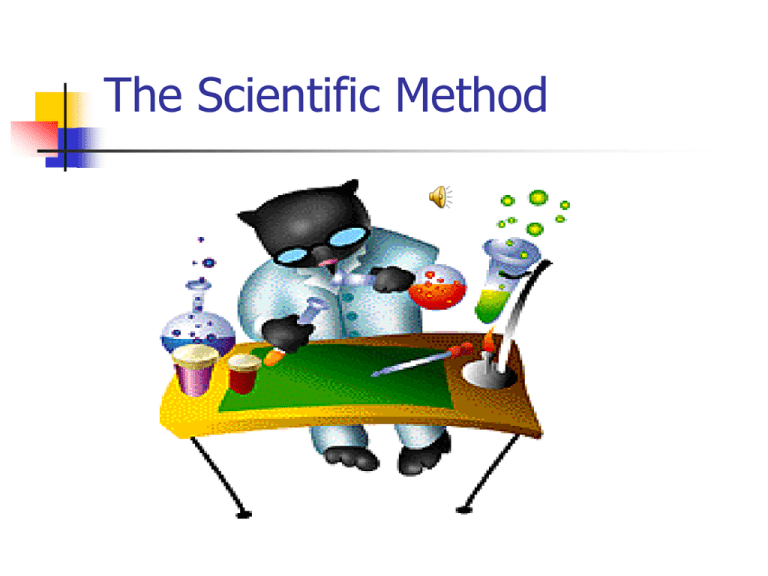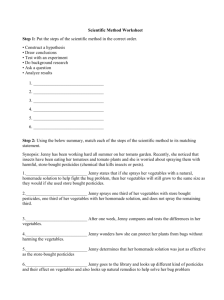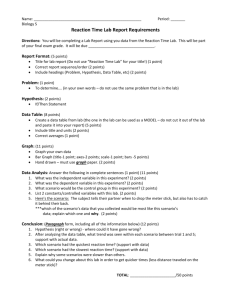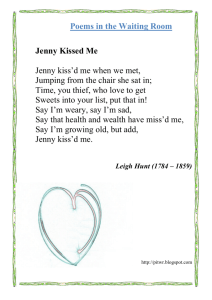The Scientific Method
advertisement

The Scientific Method The Scientific Method The scientific method is the only scientific way accepted to back up a theory or idea. This is the method on which all research projects should be based. The Scientific Method is used by researchers all over the world to support or disprove a theory. The Scientific Method is a logical and rational order of steps by which scientists come to conclusions about the world around them…. Simply put… Science is the search for knowledge The Scientific Method The Scientific Method involves 9 steps: 1 - Observation 2 – Question 3 - Gather information 4 - Hypothesis 5 – Experimentation/Procedure 6 – Collect Data 7 - Analyze 8 - Conclusion 9 – Share Result with your Peers Observation - You observe something in the material world, using your senses or machines which are basically extensions of those senses. AH—Look at this! Question - You ask a question about what you observe. State the problem or question. Gather Information Research and gather information on your question to form a stronger hypothesis (educated guess). Hypothesis - You predict what you think the answer to your question might be. A good hypothesis is written as an “If ___, then ___” statement. An educated guess. Experimentation/Procedure - You figure out a way to test whether the hypothesis is correct. The outcome must be measurable (quantifiable). AND it must be “REPEATABLE” Collect and Record Data Name, date and time/period , along with location and Title -Record all data, pertinent facts and changes of the experiment. -Then Analyze the data, statistically and inferentially. -Recording and Analyzing of data is sometimes considered two different steps. Analyze Results • Organize data • Calculate and Analyze • Then Analyze the data, statistically • and inferentially. • Repeat experiment. Why? Conclusion - You state whether your hypothesis/prediction was confirmed or not and try to explain your results. Share Results Share your findings with your peers. In today’s scientific community, results can be shared “Globally”, in seconds, with a click of a button. List five ways we can connect “Globally” with our peers. Test Your Knowledge PART 1: Match the following components of the Scientific Method to their definitions. 1. ___ Analyze 2. ___ Hypothesis 3. ___ Conclusion 4. ___ Problem 5. ___ Procedure 6. ___ Observations 7. ___ Research 8. ___ Share 9. ___ Record data A. States the question. B. Tells what happened during your experiment. C. Send results to peers D. Explains why your results happened. E. Collects information from experiment F. Prediction to the question. Educated Guess G. Shows the steps you took to do your experiment. H. 1st. And most important facet of science. I. Gather information Experimental Groups Control – Does not change, Variable – Changes Independent variable – Changed by experimenter to cause change Dependent variable – resulting changes of independent variable Direct variable – both variables change in the same direction Indirect variable – both variables change in opposite direction Changes = Delta = Changing quantities are called variables. A variable is any factor, trait, or condition that can exist in differing amounts or types. An experiment “usually” has three kinds of variables: controlled, independent, and dependent. Quanatative In a good experiment, the scientist must be able to measure the values for each variable. Measurable Emotions are hard to measure. In Variable Summary Controlled variables answer the question "What do I keep the same?“ Independent variables answer the question "What do I change?“ Dependent variables answer the question "What do I observe?" Extraneous variables answer the question "What uninteresting variables might mediate (cause) an effect. In Variable Video https://www.youtube.com/watch?v=x2 606GQmDqY Extra Variables Direct - Indirect Extraneous – are uninteresting variables other than the independent variable that may bear any effect on the behavior of the subject being studied. Such as age, gender, race, nationality… Direct Variable We have direct variation if the two variables change in the same sense; i.e. if one increases, so does the other. • Indirect Variable • We have indirect variation if one going up causes the other to go down. An example of this might be speed and time to do a particular journey; so the higher the speed, the shorter the time. Direct vs. Indirect Variable Video https://www.youtube.com/watch?feature=fvwp&v =pQ8-ktmNAC4&NR=1 List in Order PART 2: Put the components of the Scientific Method into the correct order. 1. __________ 6. __________ 2. __________ 7. __________ 3. __________ 8. __________ 4. __________ 9. __________ 5. __________ Scenario Synopsis: •________________________ Jenny states that if she sprays her vegetables with a natural, homemade solution to help fight the bug problem, then her vegetables will still grow to the same size as they would if she used store bought pesticides •_________________________Jenny tells her grandfather how her experiment went. He tries her homemade solution in his garden with the same results. Scenario •_________________________Jenny sprays one third of her vegetables with store bought pesticides, one third of her vegetables with her homemade solution, and does not spray the remaining third (her control group) •________________________ After one week, Jenny compares and tests the differences in her vegetables •________________________ Jenny wonders how she can protect her plants from bugs without harming the vegetables Scenario •________________________ Jenny determines that her homemade solution was just as effective as the store-bought pesticides •______________________ Jenny goes to the library and looks up different kind of pesticides and their effect on vegetables and also looks up natural remedies to help solve her bug problem •_______________________ Jenny has been working hard all summer on her tomato garden. Recently, she noticed that insects have been eating her tomatoes and tomato plants and she is worried about spraying them with harmful, store-bought pesticides The Scientific Method •Test you knowledge by creating a Scientific Scenario. •Observe and pick out a question that needs answering. •Follow and describe each step of the The Scientific Method. •Design an Experiment to test your scenario’s hypothesis Create a Scientific Scenario Create a scenario using the 9 listed Scientific Method steps with your lab group similar to the scenario above. Design an Experiment for Your Scenario •Design an experiment for your Scenario. •Include: • Reasoning and expected outcomes. • Procedure/Steps •Control group, independent and dependent variables, direct and indirect variables • Materials List • Safety





